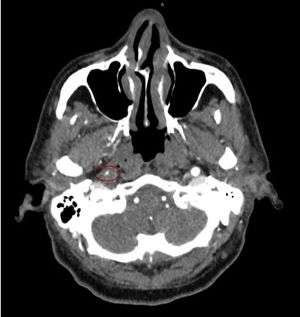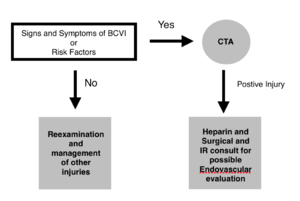Vertebral and carotid artery dissection
Background
- Primarily categorized as Spontaneous vs. Traumatic
- Most frequent cause of CVA in young and middle-aged patients (median age - 40yrs)
- Symptoms may be transient or persistent
- Consider in trauma patient who has neurologic deficits despite normal head CT
- Consider in patient with CVA + neck pain

CTA brain showing filling defect in the right carotid artery (circled)
Anatomy
- Vertebral artery comes off the subclavian and runs upward through the formina in the transverses processes of C6 to C2.
Risk Factors
- Neck trauma (often minor)
- Symptoms typically occur 2-3 days after event
- Cervical manipulation
- Coughing
- Connective tissue disease
- History of migraine[1]
Clinical Features
Internal Carotid Dissection
- Unilateral headache, face pain, anterior neck pain
- Pain can precede other symptoms by hours-days (median 4d)
- Headache most commonly is frontotemporal; severity may mimic SAH or preexisting migraine
- Partial Horner syndrome (miosis and ptosis) in 50% of cases
- Cranial nerve palsies
Vertebral Artery Dissection
- Posterior neck pain, headache
- May be unilateral or bilateral
- Headache is typically occipital
- Unilateral facial paresthesia
- Dizziness
- Vertigo
- Nausea/vomiting
- Diplopia and other visual disturbances
- Ataxia
- Lateral Medullary Syndrome seen in up to 20% of cases of VAD[2][3]
Differential Diagnosis
Evaluation
- Denver screening criteria is one way to evaluate for blunt cerebrovascular injury (BCVI)
- If positive findings on screening → obtain CTA or MRA (CTA has been shown to be equivalent to MRA)
Denver screening criteria for blunt cerebrovascular injury
The Denver Screening Criteria are divided into risk factors and signs and symptoms
Signs and Symptoms
- Arterial hemorrhage
- Cervical bruit
- Expanding neck hematoma
- Focal neurologic deficit
- Neuro exam inconsistent with head CT
- Stroke on head CT
Risk Factors
- Midface Fractures (Le Fort II or III)
- Basilar Skull Fracture with carotid canal involvement
- Diffuse axonal injury with GCS<6
- Cervical spine fracture
- Hanging with anoxic brain injury
- Seat belt abrasion or other soft tissue injury of the anterior neck resulting in significant swelling or altered mental status

Algorithm for evaluation of BCVI with high risk criteria based on Memphis and Denver Screening Criteria
Management
- Anticoagulation (prevents clot propagation along dissecting lumen) followed by vascular repair is the generally accepted treatment.[6]
- Obtain emergent vascular surgery consult for possible endovascular intervention
tPA
- Do not give if dissection enters the skull (ie Intracranial)
- Do not give if aorta is involved
- Otherwise, give according to same guidelines as for ischemic CVA (see CVA (tPA))
Antiplatelet vs Anticoagulation Therapy
Very controversial with poor data
- Heparin: If dissection causes neuro deficits and is EXTRACRANIAL
- Aspirin: If dissection is INTRACRANIAL
- Aspirin: If dissection is extracranial but no neuro deficit, for prevention of thromboembolic event
- If tPA was given, wait 24hr before starting antiplatelet therapy
- Do not give if NIHSS score ≥ 15 (risk of hemorrhagic transformation)
Complications
See Also
References
- De Giuli V et al. Association Between Migraine and Cervical Artery Dissection: The Italian Project on Stroke in Young Adults. JAMA Neurol. Published online March 6, 2017. doi:10.1001/jamaneurol.2016.5704
- Lee MJ, Park YG, Kim SJ, Lee JJ, Bang OY, Kim JS. Characteristics of stroke mechanisms in patients with medullary infarction. Eur J Neurol. 2012;19(11):1433-1439.
- Kim JS. Pure lateral medullary infarction: clinical-radiological correlation of 130 acute, consecutive patients. Brain. 2003;126(Pt 8):1864-1872.
- DiPerna CA, Rowe VL, Terramani TT, et al. Clinical importance of the “seat belt sign” in blunt trauma to the neck. Am Surg. 2002;68:441–445
- Rozycki GS, Tremblay L, Feliciano DV, et al. A prospective study for the detection of vascular injury in adult and pediatric patients with cervicothoracic seat belt signs. J Trauma. 2002;52:618–623; discussion 623–624
- Zinkstok SM, Vergouwen MD, Engelter ST, et al. Safety and functional outcome of thrombolysis in dissection-related ischemic stroke: a meta-analysis of individual patient data. Stroke. 2011;42:2515–2520.
This article is issued from
Wikem.
The text is licensed under Creative
Commons - Attribution - Sharealike.
Additional terms may apply for the media files.